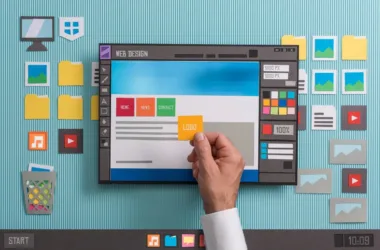Imagine a world where medical records are readily accessible at the touch of a button, consultations happen virtually from the comfort of your home, and data-driven insights empower healthcare professionals to deliver personalized care.
So, in this article, we will see how software development for healthcare is shaping the future.
Challenges of Traditional Healthcare Systems
Traditional healthcare systems often face challenges such as:
- Paper-based record-keeping: Manual record management is time-consuming, prone to errors, and hinders efficient information sharing.
- Limited accessibility: Geographic barriers or lack of transportation can restrict access to quality healthcare services.
- Disjointed communication: Fragmented communication between healthcare providers can lead to inefficiencies and potential errors in patient care.
- Data silos: Lack of data integration between different healthcare systems impedes a holistic view of a patient’s health.
The Promise of Software Development in Healthcare
Software development offers innovative solutions to these challenges and revolutionizes patient care:
- Improved accessibility: Telemedicine platforms allow remote consultations, expanding access to specialists and care for geographically dispersed populations.
- Enhanced communication: Secure communication tools enable seamless information exchange between doctors, nurses, and patients, fostering collaborative care.
- Data-driven insights: Electronic health records (EHR) systems and analytics tools provide valuable data to improve diagnoses, personalize treatment plans, and predict potential health risks.
So, by harnessing the power of software development, healthcare providers can streamline workflows, improve patient engagement, and deliver better quality care.
Key Areas of Software Development for Healthcare
Let’s delve into some of the key areas where software development plays a crucial role in healthcare:
Electronic Health Records (EHR) Systems
EHRs serve as a digital repository for a patient’s medical history, medications, allergies, and immunizations. This centralized system improves accessibility, reduces medical errors, and facilitates collaborative care.
Telemedicine and Remote Patient Monitoring
Telemedicine platforms enable virtual consultations between patients and healthcare providers. They offer increased access to specialists and remote monitoring of chronic conditions.
Healthcare Administration and Practice Management Software
These software solutions streamline administrative tasks. These include appointment scheduling, billing, and claims management, freeing up valuable time for patient care.
Medical Imaging and Diagnostics Software
Advanced software empowers radiologists and doctors to analyze medical images more efficiently and accurately. This leads to faster diagnoses and improved treatment plans.
Patient Engagement and mHealth Solutions
Mobile apps and patient portals empower patients to manage their health. They schedule appointments, and access educational resources, promoting active participation in their healthcare journey.
Benefits of Software Development for Healthcare Providers and Patients
The integration of software development into healthcare offers a multitude of benefits for both healthcare providers and patients:
Improved Efficiency and Streamlined Workflows
Software automates repetitive tasks such as scheduling, billing, and data entry, allowing healthcare professionals to dedicate more time to patient care.
Enhanced Patient Care and Communication
Secure messaging platforms within EHR systems facilitate better communication between doctors and patients, fostering trust and collaboration in care decisions.
Data-Driven Decision Making and Improved Medical Outcomes
Data analysis from EHRs and other healthcare software tools provides valuable insights into patient populations, disease trends, and treatment effectiveness. This empowers healthcare providers to make data-driven decisions and personalize treatment plans for better outcomes.
Cost Reduction and Resource Optimization
By streamlining workflows, reducing errors, and optimizing resource allocation, healthcare software development can lead to significant cost savings for healthcare institutions.
Additionally, identify potential risk factors for a disease based on real-time data, and tailor a treatment plan accordingly. This is the power of data-driven healthcare facilitated by software development.
Challenges and Considerations in Healthcare Software Development
While the potential benefits are vast, there are challenges to consider when implementing software solutions in healthcare:
- Data Security and Patient Privacy: Protecting sensitive patient data is paramount. Secure software development practices and strict adherence to HIPAA regulations are essential.
- Interoperability and Integration with Existing Systems: Ensuring seamless integration of new software with existing healthcare IT infrastructure is crucial to avoid data silos and optimize workflows.
- User Adoption and Training for Healthcare Professionals: Healthcare professionals need adequate training and support to adapt to new software systems effectively. User-friendly interfaces and ongoing training programs are key to successful adoption.
- Regulatory Compliance and HIPAA Requirements: Healthcare software development must comply with strict regulations like HIPAA (Health Insurance Portability and Accountability Act) to ensure patient data privacy and security.
So, addressing these challenges requires careful planning, collaboration between software developers and healthcare providers, and a commitment to ongoing security measures.
The Future of Software Development in Healthcare
The future of healthcare is brimming with innovative possibilities driven by software development:
Artificial Intelligence (AI) and Machine Learning in Healthcare
AI algorithms can analyze vast amounts of medical data to identify patterns, predict potential health risks, and personalize treatment plans.
Imagine AI-powered tools assisting doctors in early disease detection or tailoring medication dosages for optimal patient outcomes.
The Rise of Wearable Technology and the Internet of Medical Things (IoT)
Wearable devices like fitness trackers and smartwatches can continuously monitor vital signs, sleep patterns, and activity levels.
This data, integrated with healthcare software platforms, provides a holistic view of a patient’s health and empowers preventative care strategies.
Blockchain Technology and Secure Data Sharing in Healthcare
Building on the secure foundation of blockchain technology, we can envision a future where a patient’s complete medical history travels seamlessly with them.
Authorized healthcare providers, regardless of location, can access this secure and transparent record with ease. This revolution in medical record management is just one example of the transformative potential that arises when we embrace advancements in healthcare software development.
Furthermore, fostering collaboration between healthcare professionals, software developers, and technology innovators unlocks a treasure trove of possibilities.
By working together, these diverse minds can create a future where technology empowers a new era of healthcare – personalized, preventative, and efficient for all. This collaborative spirit holds the key to unlocking a healthier future for everyone.
Conclusion: Investing in Healthcare Software Development for a Healthier Future
The integration of software development into healthcare is no longer a futuristic vision; it’s the present reality shaping a healthier future.
However, by harnessing the power of technology, we can revolutionize patient care, empower healthcare providers, and achieve better health. From streamlining workflows to enabling data-driven decisions, the benefits are undeniable.
Thus, investing in well-designed, secure, and user-friendly healthcare software solutions is an investment in a healthier tomorrow. As technology continues to evolve, the possibilities for innovation in healthcare software development are limitless.
Furthermore, by embracing these advancements, we can create a healthcare system that is more efficient, effective, and accessible for everyone.
FAQs: Software Development for Healthcare
1. Custom vs. Off-the-Shelf Software: Which is Right for My Healthcare Organization?
Off-the-shelf software solutions might seem appealing due to their quicker availability and potentially lower upfront costs.
However, it’s important to consider the long-term implications. These generic programs may not perfectly align with the specific workflows, patient population needs, and compliance requirements of your healthcare organization.
In contrast, custom software development offers a tailored solution designed to seamlessly integrate with your existing systems, address your unique challenges, and ensure adherence to regulations.
While the initial investment might be higher, the long-term benefits of a custom-built solution that empowers your team and optimizes patient care can outweigh the initial cost.
2. Choosing the Right Software Development Partner: What Qualities Should I Look For?
Finding the right software development partner is crucial for the success of your healthcare IT initiatives. Here are some key qualities to prioritize:
- Industry Experience: Look for a company with a proven track record of success in developing software specifically for the healthcare industry. This ensures they possess a deep understanding of the unique challenges and regulatory landscape surrounding healthcare IT.
- Data Security Expertise: Data security is paramount in healthcare. Partner with a company that prioritizes secure coding practices, adheres to industry best practices, and offers ongoing security maintenance for your software solution.
- Clear Communication and Collaboration: Effective communication and a collaborative approach are essential. Look for a development partner that actively listens to your needs, clearly explains technical concepts, and fosters a collaborative working relationship throughout the development process.
3. Ensuring Patient Data Security: How Can Software Development Help?
Partnering with a reputable software development company that prioritizes data security is the first step. These companies will implement secure coding practices throughout development, adhering to industry standards like HIPAA.
Additionally, ongoing security maintenance plans ensure your software solution remains protected against potential vulnerabilities.
4. Training Healthcare Professionals: How Can We Ensure Successful User Adoption?
The specific training needs will vary depending on the complexity of the software implemented. However, a successful transition requires a multi-pronged approach:
- User-Friendly Interfaces: Investing in software with intuitive and user-friendly interfaces minimizes the learning curve for healthcare professionals.
- Comprehensive Training Programs: Providing comprehensive training programs that cater to different learning styles ensures all staff members are comfortable using the new software effectively.
- Ongoing Support: Offering ongoing technical support allows healthcare professionals to address any questions or challenges they encounter as they become familiar with the software.
5. Staying Informed: How Can Healthcare Organizations Keep Up with the Latest Advancements?
The healthcare software development landscape is constantly evolving. Here are a few ways to stay informed about the latest advancements:
- Industry Conferences: Attending industry conferences and workshops provides valuable insights into emerging technologies and trends in healthcare IT.
- Technology Partnerships: Collaborating with reputable technology partners allows you to leverage their expertise and stay ahead of the curve regarding new software solutions.
- Active Research: Dedicating time to research and explore new software developments can help you identify solutions that can further optimize your healthcare organization’s operations and patient care delivery.
So, by prioritizing these strategies, healthcare organizations can ensure they are equipped to harness the full potential of software development and navigate the exciting future of patient care.






